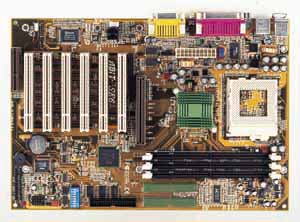Intel i815 / i815E Motherboard Roundup - August 2000
by Mike Andrawes on August 3, 2000 5:25 AM EST- Posted in
- Motherboards
|
ABIT SE6 |
|
|
CPU Interface
|
Socket-370
|
|
Chipset
|
Intel i815E
|
|
Form Factor
|
ATX
|
|
Bus Speeds
|
66
/ 68 / 70 / 72 / 75 / 77 (2:3:1)
83 / 90 / 100 / 103 / 112 / 115 / 120 / 125 (3:3:1) 125 / 130 / 133 / 137 / 140 / 145 / 150 / 153 / (4:3:1) 125 / 128 / 130 / 133 / 137 / 140 / 145 / 150 / 153 (4:4:1) |
|
Voltages Supported
|
1.30 - 1.85V in 0.05V increments
|
|
Memory Slots
|
3 168-pin DIMM Slots
|
|
Expansion Slots
|
1 AGP Slot
6 PCI Slots (3 Full Length) 0 ISA Slots 1 CNR Slot (Shared) |
|
On-board Audio
|
Avance Logic ALC100 AC'97 CODEC
|
|
BIOS
|
Award Modular BIOS 6.00PG
ABIT SoftMenu II |
ABIT has always catered to tweakers, starting with the release of the i430HX-based IT5H over 3 years ago, so it's no surprise that nearly every motherboard by ABIT is greatly anticipated. Their i815E solution, the SE6, has similar expectations to live up to and overall they've done a pretty good job, although there's still room for improvement.
The first thing we noticed about the SE6 is a small step backwards for ABIT - the inclusion of SoftMenu II instead of the more powerful SoftMenu III that we've seen on recent ABIT BX boards. The price to pay is the loss of FSB speeds in 1 MHz increments and a number of tweaking options. Fortunately, SoftMenu II retains the key elements that put ABIT on the map - a fully jumperless CPU setup with CPU core voltage tweaks and lots of FSB options. FSB speeds of 66 / 68 / 70 / 72 / 75 / 77 / 83 / 90 / 100 / 103 / 112 / 115 / 120 / 125 / 128 / 130 / 133 / 137 / 140 / 145 / 150 / 153 are all available. We'd like to see some speeds above 153 MHz as speeds up to 166 MHz have run reliably in the AnandTech labs on other motherboards.
The FSB:SDRAM:PCI ratio is in parenthesis next to the FSB speed in the BIOS, so you can always figure out what speed the memory and PCI are running at. Settings between 66 and 77 MHz use a 2:3:1 FSB:SDRAM:PCI, while 83 - 125 MHz settings are available with a 3:3:1 FSB:SDRAM:PCI ratio, and 125 - 153 can take advantage of either a 4:3:1 or 4:4:1 ratio. These ratios are, of course, what allow you to run your memory synchronously or asynchronously with the front side bus for maximum performance or compatibility with older PC100 modules with a 133 MHz CPU. Also, it should be noted that the default FSB:SDRAM:PCI ratio for 133 MHz CPU's is 4:3:1, resulting in 100 MHz memory operation even if PC133 modules are installed. It's simple enough to change, but definitely something to watch out for.
The AGP ratio is not listed anywhere, but is automatically set by the BIOS to the appropriate setting.
All memory timings can be adjusted in the BIOS, as with most of the other boards in this roundup. Unfortunately, the SE6 is one of the many here that we noticed was not stable at CAS 2 in conjunction with a 133 MHz SDRAM speed - despite using CAS 2 Micron -7E SDRAM modules. Once set to CAS 3, we had a rock solid motherboard once again.
ABIT has begun using the Winbond W83627HF I/O controller, which includes integrated hardware monitoring support. Like most previous ABIT boards, the CPU temperature is read via the CPU's on-die thermal diode and an external thermistor header is available for monitoring the temperature of anything in your system. Unfortunately, ABIT is no longer including a thermistor cable with their motherboards. Similarly, the bracket for using the second set of USB ports is also not included in the SE6 box.
It should be noted that ABIT also has a standard i815 board using the original ICH, known as the SL6. Other than the features of the ICH2, everything on the SL6 is pretty much identical to the SE6.











0 Comments
View All Comments